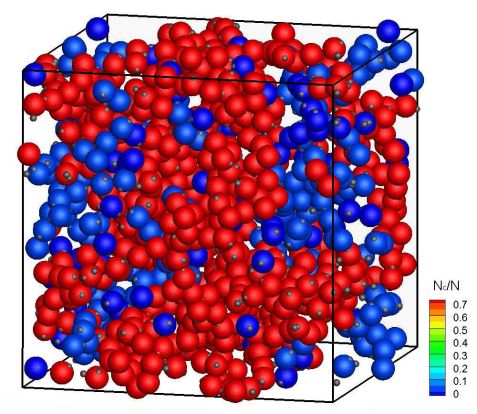MLZ is a cooperation between:
 > Technische Universität München
> Technische Universität München > Helmholtz-Zentrum Hereon
> Helmholtz-Zentrum Hereon
 > Forschungszentrum Jülich
> Forschungszentrum Jülich
MLZ is a member of:
 > LENS
> LENS > ERF-AISBL
> ERF-AISBL
MLZ on social media:

MLZ (eng)
Lichtenbergstr.1
85748 Garching
9.12.2016
Focused Interactions Important for Protein Dynamics

When areas on the surface of protein molecules (shown here by small grey dots) interact more strongly with each other than their environment, these proteins aggregate increasingly already at concentrations that are far from a dense package. In this image, these highly interconnected clusters are highlighted in different colours (red/blue: extensive/little contact with neighbouring molecules). This gel formation significantly limits the diffusion dynamics thereby extending the time which the proteins have available to function together. © Universität Lund
Many biological processes in cells function solely due to the phenomenon of diffusion. This ensures that particles are able to move randomly and aimlessly on the basis of their thermal energy alone. In this way, protein molecules get into close enough proximity to each other to, for example, carry out metabolic processes only achievable when acting together. A team of international researchers has now shown that weak attraction forces between proteins can enormously influence diffusion, if the protein molecules are as densely concentrated as under natural conditions in living cells.
The influence of interactions in such high protein concentrations is extremely difficult to quantify experimentally. Because of this, until now many measurements have been made in diluted solutions. Neutron scattering experiments performed among other places at the Jülich outstation at the Heinz Maier-Leibnitz Zentrum in Garching, and computer simulations carried out in Jülich have now made studies possible in physiological concentrations. The results verify on one hand the excellent suitability of neutron scattering for this type of experimental work and on the other, that computer simulations must take the specific molecular properties of proteins, such as their surface structure, far more into consideration in order to arrive at realistic predictions.Text: Angela Wenzik / FZ Jülich
Original publication:
Saskia Bucciarelli, Jin Suk Myung, Bela Farago, Shibananda Das, Gerard Vliegenthart, Olaf Holderer, Roland G. Winkler, Peter Schurtenberger, Gerhard Gompper, Anna Stradner; Dramatic influence of patchy attractions on short-time protein diffusion under crowded conditions;
Science Advances 2: e1601432 (2016); DOI: 10.1126/sciadv.1601432
MLZ is a cooperation between:
 > Technische Universität München
> Technische Universität München > Helmholtz-Zentrum Hereon
> Helmholtz-Zentrum Hereon
 > Forschungszentrum Jülich
> Forschungszentrum Jülich
MLZ is a member of:
 > LENS
> LENS > ERF-AISBL
> ERF-AISBL
MLZ on social media:


